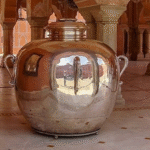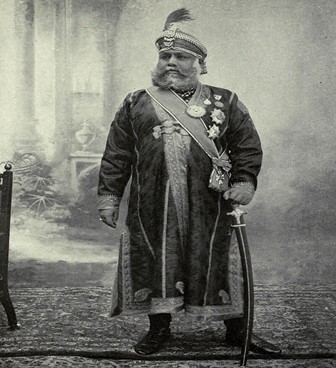The Maharaja of Jaipur and the Silver Vessels of Gangajal
History is filled with episodes where cultural traditions, religious devotion, and royal grandeur intersect to create stories that are larger than life. Among them, one of the most fascinating tales belongs to Maharaja Sawai Madho Singh II of Jaipur, who, at the turn of the 20th century, embarked on a journey from the deserts of Rajasthan to the heart of the British Empire—London. His voyage was not just diplomatic; it was spiritual, cultural, and symbolic. And what made it legendary was the extraordinary act of carrying the sacred waters of the River Ganga to a foreign land in vessels that today stand as marvels of craftsmanship.
This is the story of faith meeting grandeur, of two giant silver urns filled with Gangajal, and of a ruler’s determination to uphold his traditions even in a distant empire.


The Royal Dilemma
The early 1900s was a period when the British crown invited Indian princes to England for state occasions. In 1902, King Edward VII’s coronation in London was to be a grand spectacle, and several Indian maharajas were summoned to mark their loyalty to the crown. Among them was Maharaja Sawai Madho Singh II of Jaipur, a devout Hindu and a ruler bound by Rajput traditions.
But for the Maharaja, traveling overseas presented a religious challenge. According to the customs of his lineage, he could not consume food or water prepared in a foreign land. The sacred waters of the Ganga were believed to purify the soul, and drinking it was essential to maintain his spiritual discipline. To compromise on this would mean violating his faith—a thought the Maharaja could not accept.
Thus, what could have been a simple royal trip turned into a logistical and cultural dilemma: How could a king from Rajasthan sustain his religious obligations in faraway England?
The Creation of the Silver Vessels
The solution lay in extraordinary craftsmanship and sheer determination. The Maharaja ordered the creation of two massive silver vessels—later to be called the Gangajalis.
- Material and Craftsmanship: The urns were made from pure silver, handcrafted by skilled silversmiths of Jaipur.
- Dimensions: Each vessel stood over 5 feet tall and measured nearly 14 feet in circumference.
- Weight and Capacity: Each weighed about 340 kilograms (over 750 pounds) and could hold approximately 4000 liters of water.
- Inscriptions: Beautifully inscribed in both Hindi and Sanskrit, they bore details about their making, adding to their artistic and cultural significance.
The silver was sourced from the royal treasury, melted, and molded into these vessels without soldering, making them not just functional but also symbolic of purity.
The Maharaja then ordered them to be filled with water drawn directly from the holy River Ganga in Haridwar.
The Voyage to England
When the Maharaja finally set sail for London, the two silver vessels accompanied him on the ship, holding thousands of liters of sacred Gangajal. This water was used for his daily consumption—for drinking, cooking, and even bathing. Every ritual that required holy water was performed without compromise, even while thousands of miles away from India.
Imagine the scene: a royal entourage aboard a ship crossing the seas, with two enormous glittering vessels of silver securely placed, containing the sacred waters of the Ganges. It was not just a personal necessity but also a statement of identity. The Maharaja was carrying India with him, in liquid form, across oceans.
Arrival in London
When the Maharaja reached London, his story became the talk of the British elite. Newspapers carried curious accounts of the exotic Indian prince who had brought his holy river to England. For the British public, it was a mixture of astonishment and admiration. For the Maharaja, however, it was a matter of preserving his dharma.
At banquets and receptions, where other princes indulged in British delicacies, Madho Singh II remained steadfast. His meals were prepared using the Gangajal, and every act was aligned with his religious principles.
The vessels themselves fascinated those who saw them. Not only were they massive in size, but their very presence in a foreign land represented the idea of tradition traveling across borders.
Symbolism and Significance
The story of the Maharaja’s silver vessels is not merely about logistics or eccentricity. It is deeply symbolic.
- Faith and Identity: In an era when colonial pressure often forced cultural compromises, the Maharaja demonstrated that one could engage with the West without losing one’s spiritual identity.
- Power and Prestige: The grandeur of the silver vessels also reflected the wealth and artistic excellence of Jaipur’s royal court. They were not just containers of water; they were monuments of craftsmanship.
Cultural Diplomacy: By staying true to his traditions while participating in a global event, the Maharaja subtly conveyed that Indian values could coexist with global politics
Legacy of the Silver Urns
After his return from England, the vessels did not fade into obscurity. Instead, they became treasures of Jaipur’s royal heritage. Today, they are preserved at the City Palace Museum in Jaipur, where they continue to awe visitors.
In recognition of their size and artistry, they were listed in the Guinness Book of World Records as the world’s largest silver vessels. Tourists from around the world visit Jaipur to witness these urns, not just for their size but for the extraordinary story they carry with them—a story of devotion, resilience, and grandeur.
The Maharaja Behind the Legend
While the vessels often overshadow the man, Maharaja Sawai Madho Singh II deserves equal attention. Known as a just and progressive ruler, he introduced reforms in education, health, and city planning in Jaipur. Yet, he never compromised on his personal religious discipline. His act of carrying Gangajal across the seas highlighted his dual role: a modern ruler willing to engage with the world and a traditional Rajput unwilling to abandon his roots.
A Living Narrative
Even today, over a century later, the tale resonates strongly. In an age of globalization, when cultural identities often blur, the Maharaja’s story stands as a reminder that traditions can travel, adapt, and survive. His silver urns of Gangajal were more than relics—they were vessels of continuity, carrying not just water but the essence of India’s spiritual heritage across continents.
Conclusion
The journey of Maharaja Sawai Madho Singh II to England with Gangajal is more than a footnote in history; it is a living documentary of faith, tradition, and royal splendor. The massive silver vessels stand today not just as objects of wonder but as storytellers of a time when kings carried rivers across oceans, when devotion dictated diplomacy, and when heritage traveled in urns of silver.
As they shine in the halls of the Jaipur City Palace, the vessels remind us of a timeless truth: that faith, when held firmly, can transcend borders, and that sometimes, history is written not just in battles or treaties, but in the extraordinary journeys of sacred water across seas.

